B0041VYHGW EBOK (111 page)
Authors: David Bordwell,Kristin Thompson

CONNECT TO THE BLOG
Early Japanese swordplay movies display some daring editing, as we demonstrate in “Bando on the run.”
Our examples indicate that some discontinuities of order, duration, and frequency can become perfectly intelligible in a narrative context. On the other hand, with the jump cut, the nondiegetic insert, and the inconsistent match on action, temporal dislocations can also push away from traditional notions of story altogether and create ambiguous relations among shots.
As an example of the power of spatial and temporal discontinuities in editing, let’s look at a famous example: Sergei Eisenstein’s
October.
October
For many Soviet filmmakers of the 1920s, editing was a major means of organizing the entire form of the film; it did not simply serve the narrative progression, as in the continuity system. Eisenstein’s
Strike, Potemkin, October,
and
Old and New
tried to build a film on the basis of certain editing devices. Rather than subordinate his editing patterns to the mapping out of a story, Eisenstein conceived of these films as editing constructions.
Eisenstein deliberately opposed himself to continuity editing, seeking out and exploiting what Hollywood would consider discontinuities. He often staged, shot, and cut his sequences for the maximum
collision
from shot to shot and sequence to sequence. He believed that by being forced to synthesize such conflicts the viewer would participate in actively understanding the film.
No longer bound by conventional dramaturgy, Eisenstein’s films roam freely through time and space. They construct intricate patterns of images calculated to stimulate the viewer’s senses, emotions, and thinking. A short passage from
October
can illustrate how he uses editing discontinuities.
The sequence is the third one in the film (and comprises over 125 shots). The story action is simple. The bourgeois Provisional Government has taken power in Russia after the February Revolution, but instead of withdrawing from World War I, the government has continued to support the Allies. This maneuver has left the Russian people no better off than under the czar. In classical Hollywood cinema, this story might have been shown through a montage sequence of newspaper headlines smoothly linked to a scene wherein a protagonist complains that the Provisional Government has not solved people’s problems.
October
’s protagonist, though, is not one person but the entire Russian people, and the film does not usually use dialogue scenes to present its story points. Rather,
October
seeks to go beyond a simple presentation of story events by making the audience actively assemble those events. So the film confronts us with a disorienting and disjunctive set of images.
The sequence begins with shots showing the Russian soldiers on the front casting down their rifles and fraternizing freely with German soldiers
(
6.152
).
Eisenstein then cuts back to the Provisional Government, where a flunky extends a document to an unseen ruler
(
6.153
)
; this document pledges the government to aid the Allies. The soldiers’ fraternization is suddenly disrupted by a bombardment
(
6.154
).
The soldiers run back to the trenches and huddle as dirt and bomb fragments rain down on them. Eisenstein then cuts to a series of shots of a cannon being lowered off a factory assembly line. For a time, the narration crosscuts these images with the soldiers on the battlefield
(
6.155
,
6.156
).
In the last section of the sequence, the shots of the cannon are crosscut with hungry women and children standing in breadlines in the snow
(
6.157
).
The sequence ends with two intertitles: “All as before … “/“Hunger and war.”
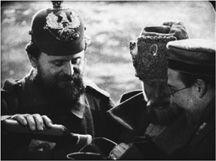
6.152 In
October,
Russian and German soldiers talk, drink, and laugh together on the battlefield.

6.153
October:
at the Provisional Government’s headquarters.

6.154
October:
a bombardment at the front.
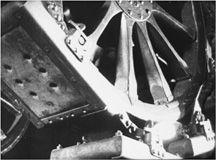
6.155 In
October,
a cannon in a factory intercut …
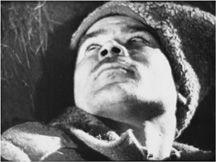
6.156 … with soldiers at the front.

6.157 In
October,
a breadline intercut with the war scenes.
Graphically, there are some continuities. When the soldiers fraternize, many shots closely resemble one another graphically, and one shot of a bursting bomb is graphically matched in its movement with men bustling into a trench. But the
discontinuities
are more noteworthy. Eisenstein cuts from a laughing German soldier facing right to a menacing eagle statue, facing left, at the government headquarters
(
6.158
,
6.159
).
There is a bold jump cut: The flunky is bowing; then suddenly he is standing up
(
6.160
,
6.161
).
A static shot of rifles thrust into the snow cuts to a long shot of a bursting shell
(
6.162
,
6.163
).
When the soldiers race back to the trenches, Eisenstein often opposes their direction of movement from shot to shot.
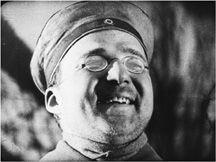
6.158
October.
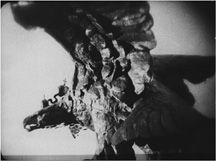
6.159
October.
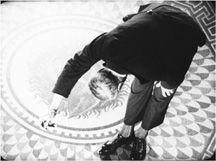
6.160
October.